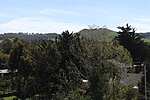San Luis Obispo (SLO) County wine is a appellation that designates wine made from grapes grown in San Luis Obispo (SLO) County, California which is sandwiched between Santa Barbara County to the south and Monterey County at the northern boundary on the Pacific coast. Its location sits halfway between the cities of San Francisco and Los Angeles on the north–south axis of U.S. Route 101 and Pacific Coast Highway (PCH). The county lies entirely within the Central Coast viticultural area. County names in the United States automatically qualify as legal appellations of origin for wine produced from grapes grown in that county and do not require registration with the Alcohol and Tobacco Tax and Trade Bureau (TTB), Treasury. TTB was created in January of 2003, when the Bureau of Alcohol, Tobacco and Firearms, or ATF, was extensively reorganized under the provisions of the Homeland Security Act of 2002.The term "SLO" is a historical and commonly used reference for the county and its county seat, San Luis Obispo, initials as well as a description of the region's relaxed culture.
According to the U.S. Census Bureau, the county has a total area of 3,616 square miles (2,314,000 acres) of which 3,299 square miles (2,111,000 acres) is land and 317 square miles (820 km2) (comprising 8.8%) is water. San Luis Obispo county is home to some of California's coolest winemaking areas similar to climatic influences as its northern counterparts, Napa and Sonoma counties.
The proximity of the Pacific coastline to the viticultural areas of San Luis Obispo Coast (SLO) Coast, and at the county's southern end, Arroyo Grande Valley, influences their vineyards to the cool marine air.
The county is home to sixteen distinctive viticultural areas (AVA) including the spacious Paso Robles with its eleven sub-region AVAs, the diminutive neighbor, York Mountain and the elongated newcomer, San Luis Obispo (SLO) Coast.







